Numerical Simulation Study on Deformation Characteristics of Surrounding Rock during Construction and Operation of Large Underground Gas Storage Structures
Abstract
:1. Introduction
2. Model
2.1. Cavern Structure Type
2.2. Constitutive Model
2.2.1. Yield Criterion
2.2.2. Plastic Flow Law
2.2.3. Unit Destruction
2.3. Boundary Conditions
3. Results and Discussion
3.1. Influence of Surrounding Rock Grade on Cavern Stability
3.1.1. Deformation Characteristics of Cavern Surrounding Rock
3.1.2. Distribution Characteristics of the Plastic Zone of Cavern Surrounding Rock
3.2. Effect of Depth-Span Ratio on Cavern Stability
3.2.1. Deformation Characteristics of Surrounding Rock
3.2.2. Distribution Characteristics of the Plastic Zone of Surrounding Rock
3.3. Effect of Burial Depth on Cavern Stability
3.3.1. Deformation Characteristics of Surrounding Rock
3.3.2. Distribution Characteristics of the Plastic Zone of Surrounding Rock
4. Conclusions
- After construction, the deformation of the rock surrounding the cavern chamber increases with the decrease in the rock grade. During the operation period, under an ultimate gas storage pressure of 20 MPa, the displacement of the surrounding rock around the cavern chamber increases with the decrease in the surrounding rock grade. Therefore, the stability of Grade II and Grade III surrounding rock can, in general, be managed.
- After construction, the deformation of the surrounding rock around the cavern is less affected by changes in the depth-span ratio. During the operation period, if an ultimate gas storage pressure of 20 MPa is applied to the interior of the cavern, the vertical displacement of the surrounding rock in the cavern decreases with the increase in the depth-span ratio, while the horizontal displacement of the surrounding rock increases with the increase in the depth-span ratio.
- After construction, the deformation of the rock surrounding the cavern chamber increases as the burial depth increases. During the operation period, the displacement of the surrounding rocks around the cavern chamber, under an ultimate gas storage pressure of 20 MPa, decreases as the burial depth of the cavern chamber increases. This is mainly due to the increase in ground stress around the surrounding rock of the cavern chamber as the burial depth of the cavern chamber increases. However, the force on the surrounding rock will be smaller for the gas storage pressure inside the cavern.
- According to the results, considering the stability of the cavern chamber’s surrounding rock during the construction period and operation period, the cavern chamber should be arranged in areas with good conditions, such as Grade II-III or better surrounding rock. Areas with Grade IV or worse surrounding rock conditions are not suitable for the construction of large underground gas storage chambers. The depth-span ratio should be 2.5~3.0, and the surrounding rock of the cavern chamber has better stability within a burial depth of 200 m.
Author Contributions
Funding
Institutional Review Board Statement
Informed Consent Statement
Data Availability Statement
Conflicts of Interest
References
- Zhang, X.P.; Wang, J.C.; Yang, S.; Diao, S. Appliance foreground of lined rock caverns (LRC). J. Qingdao Technol. Univ. 2009, 30, 107–111. [Google Scholar]
- Nilsen, B. Norwegian oil and gas storage in rock caverns-Technology based on experience from hydropower development. J. Rock Mech. Geotech. Eng. 2021, 13, 479–486. [Google Scholar] [CrossRef]
- Wang, H.B. Development status of underground gas storage in China and application of geological orientation. West China Prospect. Eng. 2021, 33, 84–86. [Google Scholar]
- Zheng, D.W. Theory and technology innovation support high quality construction of gas storage in China. China Petroleum News, 6 May 2021. [Google Scholar]
- Ding, G.S.; Ding, Y.C.; Li, Y.; Tang, L.G.; Wu, Z.D.; Wan Yan, Q.Q.; Xun, H.C.; Wang, Y. Prospects for China’s Underground Gas Storage under Carbon Neutralization Strategy. Oil Gas Storage Transp. 2022, 41, 397. [Google Scholar]
- Hong, K.R. Development and application of construction technologies for underground water-sealed energy storage caverns. Tunn. Constr. 2014, 34, 188–197. [Google Scholar]
- Ma, H.; Yang, C.; Li, Y.; Shi, X.L.; Liu, J.F.; Wang, T.T. Stability evaluation of the underground gas storage in rock salts based on new partitions of the surrounding rock. Environ. Earth Sci. 2015, 73, 6911–6925. [Google Scholar] [CrossRef]
- Raghavan, N. A Novel Method of Construction of a Deep Underground Cavern for Storage of Liquefied Petroleum Gas. Struct. Eng. Int. 2013, 23, 30–33. [Google Scholar] [CrossRef]
- Lu, M. Finite element analysis of a pilot gas storage in rock cavern under high pressure. Eng. Geol. 1998, 49, 353–361. [Google Scholar] [CrossRef]
- Johansson, J. High-Pressure Storage of Gas in Lined Rock Caverns: Cavern Wall Design Principles; Division of Soil & Rock Mechanics Royal Institute of Technology: Stockholm, Sweden, 2003. [Google Scholar]
- Zimmels, Y.; Kirzhner, F.; Krasovitski, B. Design criteria for compressed air storage in hard rock. Energy Environ. 2002, 13, 851–872. [Google Scholar] [CrossRef]
- Glamheden, R.; Curtis, P. Excavation of a cavern for high-pressure storage of natural gas. Tunn. Undergr. Space Technol. 2006, 21, 56–67. [Google Scholar] [CrossRef]
- Bagci, A.S.; Ozturk, E. Performance Prediction of Underground Gas Storage in Salt Caverns. Energy Sources Part B 2007, 2, 155–165. [Google Scholar] [CrossRef]
- Peng, Z.H.; Zhang, B.; Li, Y.T.; Li, J.Y.; Shi, L. Study on surrounding rock stability and water-sealed reliability of underground crude oil storage cavern in island. Chin. J. Undergr. Space Eng. 2020, 16, 1875–1881. [Google Scholar]
- Li, Y.T.; Zhang, B.; Shi, L.; Peng, Z.H.; Li, J.Y. Enlargement layout of underground water-sealed oil storage cavern with vertical water curtain system. Tunn. Constr. 2019, 39, 1308–1318. [Google Scholar]
- Yuan, W.Z.; Xu, G.C.; Gu, J.C.; Zhang, X.Y.; Jie, X.H. Test study on damaged effects of large-span underground cavern under explosion. Chin. J. Undergr. Space Eng. 2019, 15, 601–606. [Google Scholar]
- Xu, G.C.; Yuan, W.Z.; Xu, J.M.; Jie, X.H.; Li, C.X. Study on Excavate Scheme of Large Span Small Sagittal Ratio Underground Cavern. Chin. J. Undergr. Space Eng. 2018, 14 (Suppl. 2), 763–768. [Google Scholar]
- Zhang, C.B.; Zhang, Y.Q. The stability simulation of oil storage caverns in large section groundwater sealed oil caverns. Oil Gas Storage Transp. 2019, 38, 827–833. [Google Scholar]
- Hu, M.P.; Liang, J.Z.; Xu, J. Numerical analysis of surrounding rock stability of groundwater sealed oil storage. Oil Gas Storage Transp. 2013, 32, 370–375. [Google Scholar]
- Peng, J.; Zhou, J.; Liang, G.; Peng, C.; Fang, S. A comprehensive stability evaluation method of multiple salt caverns underground gas storage with interlayers. Pet. Sci. Technol. 2022, 40, 1600–1621. [Google Scholar] [CrossRef]
- Chen, X.; Zhang, Q.; Li, S.; Liu, D. Geo-mechanical model testing for stability of underground gas storage in halite during the operational period. Rock Mech. Rock Eng. 2016, 49, 2795–2809. [Google Scholar] [CrossRef]
- Zhang, G.; Wang, L.; Wu, Y.; Li, Y.; Yu, S. Failure mechanism of bedded salt formations surrounding salt caverns for underground gas storage. Bull. Eng. Geol. Environ. 2017, 76, 1609–1625. [Google Scholar] [CrossRef]
- Chen, W.Z.; Wu, G.J.; Dai, Y.H.; Yang, C.H. Stability analysis of abandoned salt caverns for underground gas storage. Chinese J. Rock Mech. Eng. 2006, 848–854. [Google Scholar]
- Jongpradist, P.; Tunsakul, J.; Kongkitkul, W.; Fadsiri, N.; Arangelovski, G.; Youwai, S. High internal pressure induced fracture patterns in rock masses surrounding caverns: Experimental study using physical model tests. Eng. Geol. 2015, 197, 158–171. [Google Scholar] [CrossRef]
- Xia, C.C.; Zhang, P.Y.; Zhou, S.W.; Zhou, Y.; Wang, R. Stability and tangential strain analysis of large-scale compressed air energy storage caverns. Rock Soil Mech. 2014, 35, 1391–1398. [Google Scholar]
- Jiang, Z.; Li, P.; Tang, D.; Zhao, H.; Li, Y. Experimental and numerical investigations of small-scale lined rock caverns at shallow depth for compressed air energy storage. Rock Mech. Rock Eng. 2020, 53, 2671–2683. [Google Scholar] [CrossRef]
- Jiang, Z.M.; Li, P.; Zhao, H.B.; Feng, S.R.; Tang, D. Experimental study on performance of shallow rock caverns for compressed air energy storage. Rock Soil Mech. 2020, 41, 235. [Google Scholar]



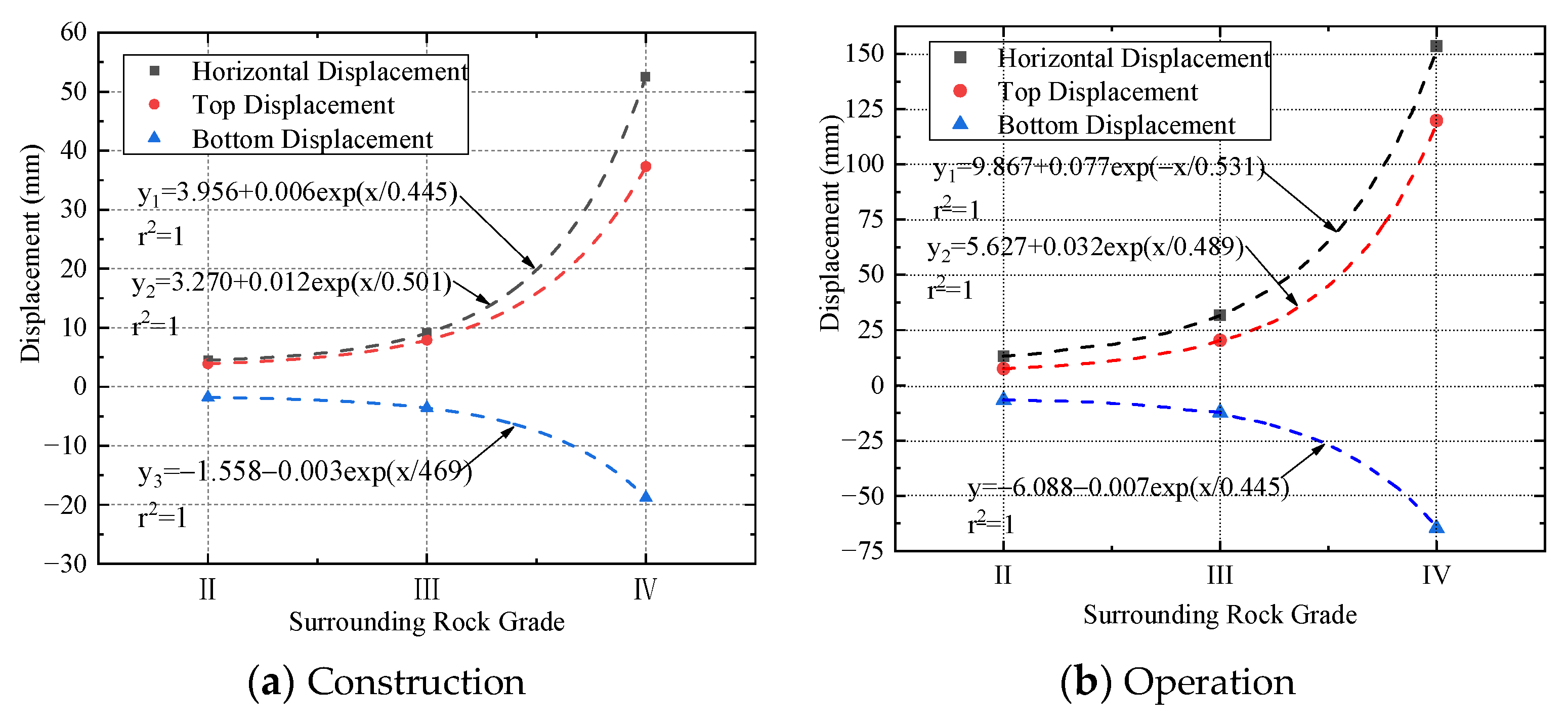
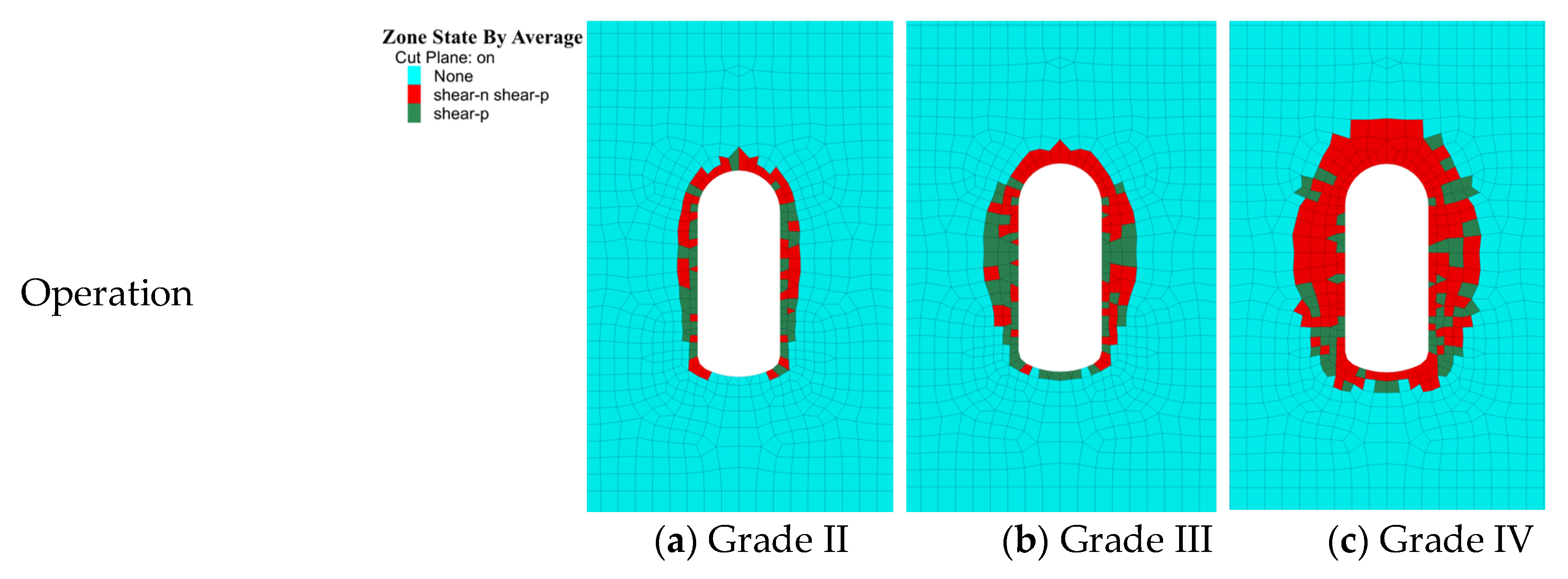

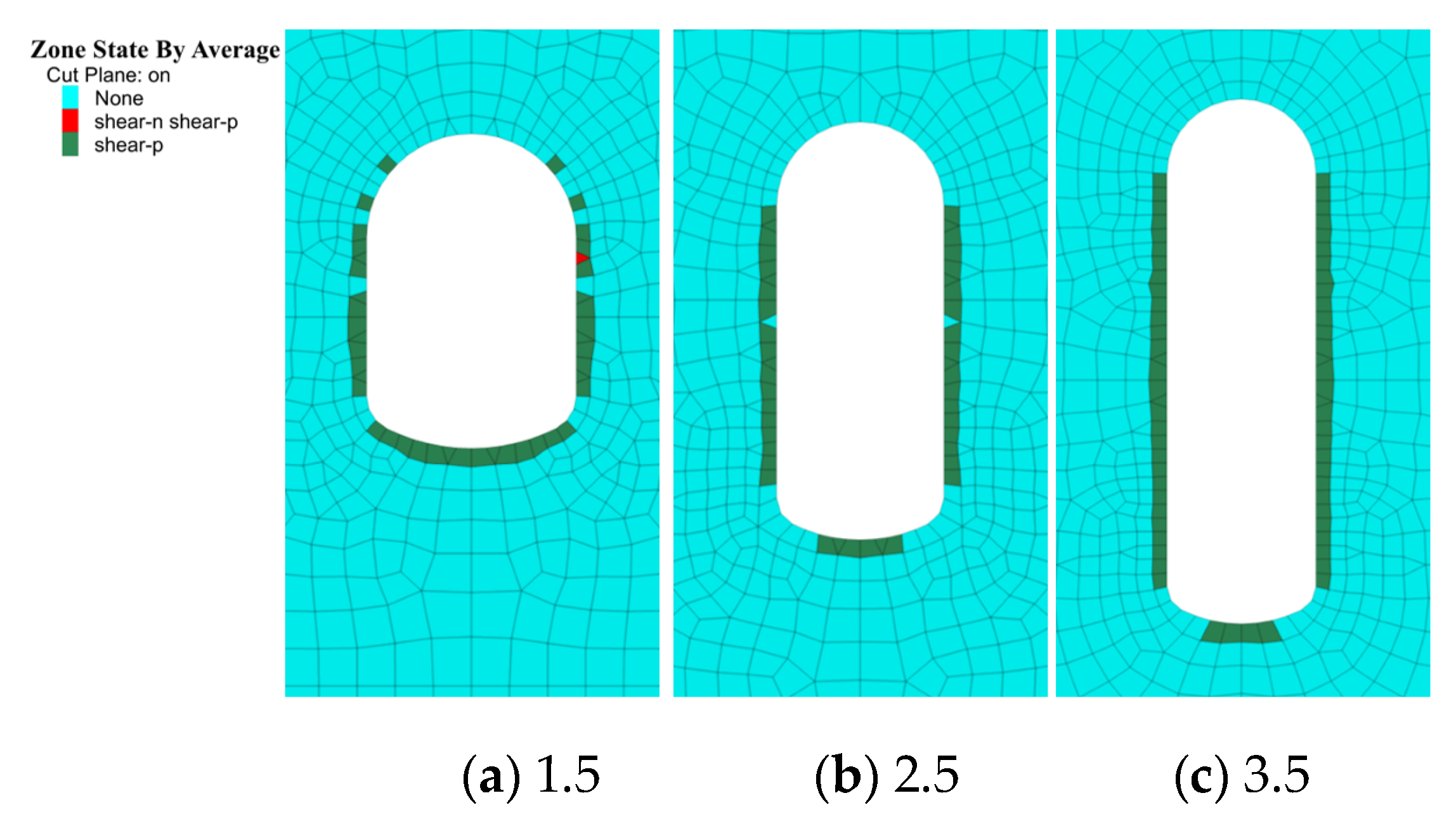
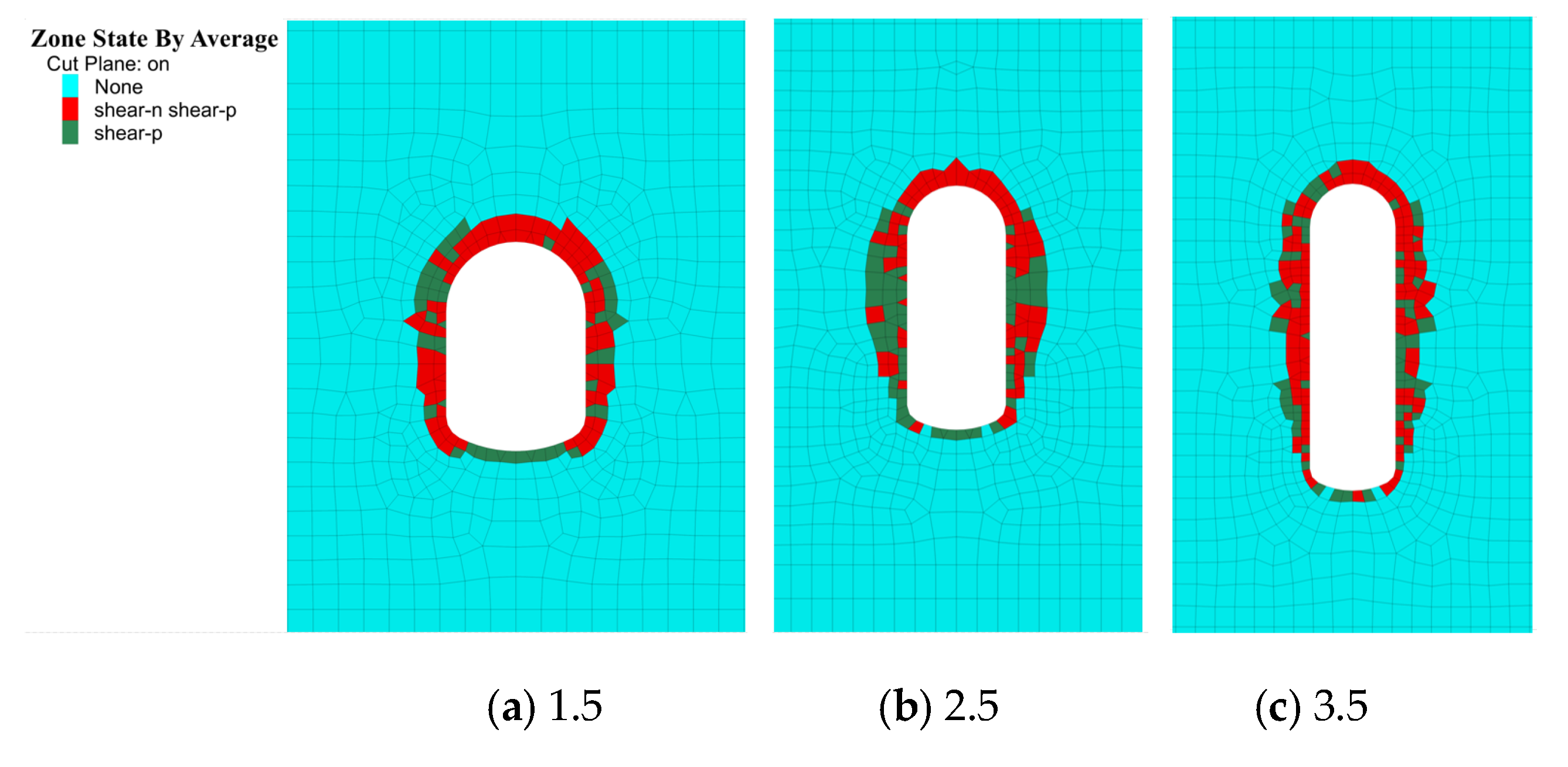
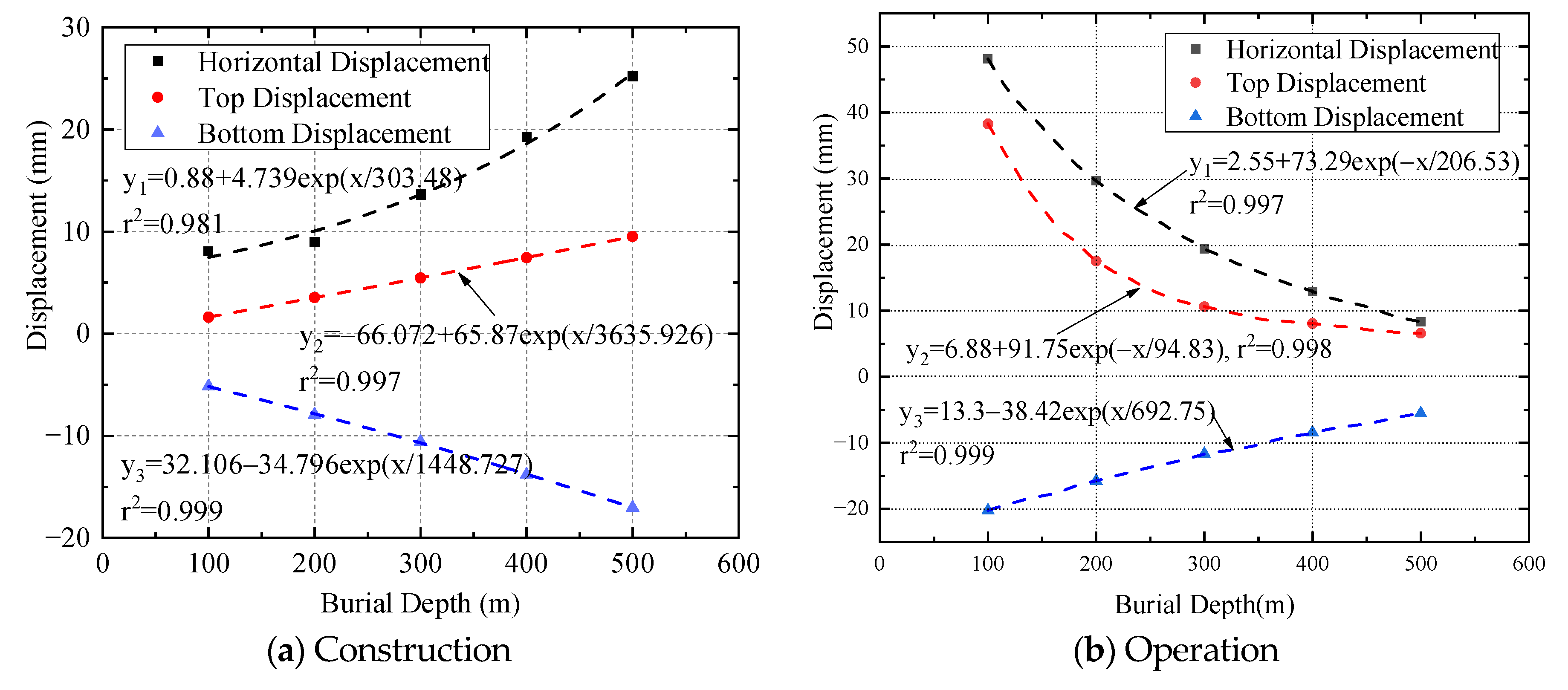


| Working Condition | Depth-Span Ratio | Surrounding Rock Grade | Buried Depths/m |
|---|---|---|---|
| S1-1 | 1.5 | III | 200 |
| S1-2 | 2 | III | 200 |
| S1-3 | 2.5 | III | 200 |
| S1-4/S2-2/S3-2 | 3 | III | 200 |
| S1-5 | 3.5 | III | 200 |
| S2-1 | 3 | Ⅱ | 200 |
| S2-3 | 3 | IV | 200 |
| S3-1 | 3 | III | 100 |
| S3-3 | 3 | III | 300 |
| S3-4 | 3 | III | 400 |
| S3-5 | 3 | III | 500 |
| Surrounding Rock Grade | Unit Weight /(kN·m−3) | Elastic Modulus/GPa | Poisson’s Ratio | Internal of Friction Angle/(°) | Cohesion/MPa | Calculation of Friction Angle /(°) |
|---|---|---|---|---|---|---|
| Ⅱ | 26 | 27 | 0.2 | 55 | 1.8 | 75 |
| III | 24 | 13 | 0.28 | 45 | 1.1 | 65 |
| IV | 22 | 4 | 0.35 | 35 | 0.5 | 55 |
Publisher’s Note: MDPI stays neutral with regard to jurisdictional claims in published maps and institutional affiliations. |
© 2022 by the authors. Licensee MDPI, Basel, Switzerland. This article is an open access article distributed under the terms and conditions of the Creative Commons Attribution (CC BY) license (https://creativecommons.org/licenses/by/4.0/).
Share and Cite
Peng, Z.; Ding, H.; Jiang, X.; Hu, X.; Cheng, L. Numerical Simulation Study on Deformation Characteristics of Surrounding Rock during Construction and Operation of Large Underground Gas Storage Structures. Sustainability 2022, 14, 16864. https://doi.org/10.3390/su142416864
Peng Z, Ding H, Jiang X, Hu X, Cheng L. Numerical Simulation Study on Deformation Characteristics of Surrounding Rock during Construction and Operation of Large Underground Gas Storage Structures. Sustainability. 2022; 14(24):16864. https://doi.org/10.3390/su142416864
Chicago/Turabian StylePeng, Zhenhua, Hao Ding, Xinghong Jiang, Xuebing Hu, and Liang Cheng. 2022. "Numerical Simulation Study on Deformation Characteristics of Surrounding Rock during Construction and Operation of Large Underground Gas Storage Structures" Sustainability 14, no. 24: 16864. https://doi.org/10.3390/su142416864





